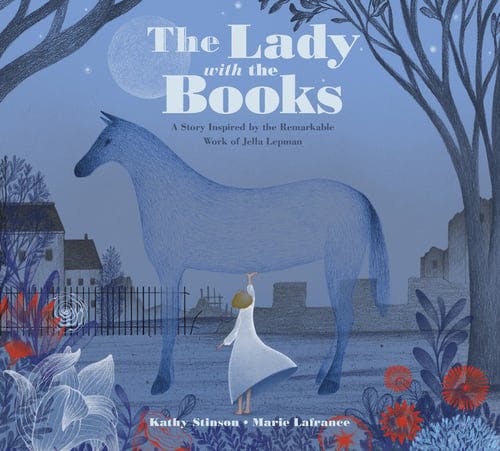

The Lady with the Books
What Does Bookroo Think of This Book
Anneliese doesn’t understand why the women try to clean the streets of rubble when the town will never be the same. With the nagging pain of hunger and the lingering heartache from losing her father in the war, Anneliese and her brother stumble upon a book exhibition, where “the lady with the books” introduces and engulfs the children in fun, relatable, hopeful, and resonating stories like Ferdinand the Bull, The Story of Babar, and Pippi Longstocking. One night, after eating a delicious stew due to the generosity of the farmer (and her mother’s selflessness trading an heirloom teapot and skill in catching a pigeon) and retiring to bed, Anneliese awakes and slips outside into the moonlight. She resolves to hope for a better future and join the women with their brooms the next day, but for now will sleep and dream, “like Ferdinand in his field of flowers.” This touching and powerful work of historical fiction is based on the true story of “the lady with the books,” Jella Lepman, who is introduced further in the inspiring back matter at the end of the book. This powerful story doesn’t shy away from or dwell on realities of war, leaving a predominant feeling of hope. Lafrance creatively integrates characters from the exhibition books peeking around the illustrations, adding additional hope to a city torn by war and further showcasing one of the powerful themes of the book, and Jella Lepman’s driving goal, of using books as “bridges of understanding.”
What Kind of Book is The Lady with the Books
What Should I Know As a Parent
Families are unique and have different expectations for the books they choose to read. The following are concepts included in this book that some parents may wish to seek out or avoid.
Note that this list is not exhaustive and there may be concepts in this book that are not included or have been insufficiently or incorrectly detailed here.
Reviews
Book Lists That Include This Book
The Creatives Behind the Book
What Has Kathy Stinson Said About This Book
Nothing yet! Let Kathy Stinson know that you want to hear from them about their book.
What Has Marie Lafrance Said About This Book
Nothing yet! Let Marie Lafrance know that you want to hear from them about their book.
More Books From These Creatives
Similar Books to This Book
Book Details
- ISBN
- 9781525301544
- Publication Date
- October 6, 2020
- Publisher
- Kids Can Press
- Original Publication Date
- October 6, 2020
- Text Details
- The text is set in Bauer bodoni.
- Illustration Details
- The artwork in this book was rendered in graphite pencil and colored digitally in Photoshop.
- Page Count
- 32
- Words Per Page
- 30
- Audience
- Picture
- Lexile® Level
- AD620L
- Est. Fountas & Pinnell Level
- ~O
- Est. ATOS® Book Level
- ~4
Contribute to this page
Are you the author or illustrator? Claim your book.



































